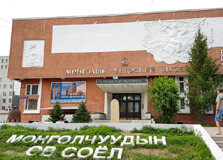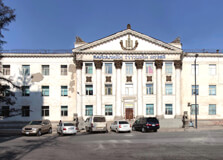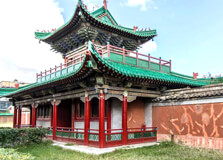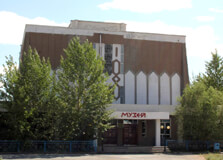
- Home
- Travel Packages
- Top Destination
-
Travel Attraction
By Category
Top Attraction

- Travel Agents
- Car Rentals
- Hotels

The National Museum of Mongolia
The National Museum of Mongolia, located in the heart of Ulaanbaatar, is one of the most significant cultural and historical landmarks in the country. It offers a fascinating journey through Mongolia’s rich past, from prehistoric times to the modern era. The museum is a must-visit for anyone interested in learning about Mongolian history, culture, nomadic lifestyle, and national identity. Established in 1991 (based on collections from older institutions), the museum holds more than 50,000 artifacts, making it the largest and most comprehensive museum in Mongolia. It showcases everything from ancient stone tools to the traditional attire of Mongolia's ethnic groups, as well as exhibits on the Mongol Empire led by Genghis Khan. How to Reach The National Museum of Mongolia The museum is conveniently located near Sukhbaatar Square in central Ulaanbaatar. Visitors can reach it by various modes of transport: By Car or Taxi: Taxis are widely available, and ride-hailing apps like UB Cab or InDriver operate in the city. By Public Transport: Local buses run frequently, and the museum is within walking distance from major stops around the city center. On Foot: If you are staying near the city center or Sukhbaatar Square, the museum is easily accessible by walking. Weather in Ulaanbaatar Ulaanbaatar has a continental climate with long, cold winters and short, warm summers. The best time to visit the museum is from May to September when the weather is mild and more favorable for sightseeing. Summer (June - August): Average temperatures range from 15°C to 25°C. Ideal for tourists. Winter (November - February): Temperatures can drop to -30°C. Not ideal for walking around, but the museum is heated and open. Spring and Autumn: Cooler weather but manageable, especially in May and September. Timings of The National Museum of Mongolia The museum is open throughout the week except for public holidays and occasional maintenance days. Monday to Friday: 9:00 AM – 6:00 PM Saturday and Sunday: 10:00 AM – 5:00 PM Closed: On major national holidays and for scheduled renovations (check the official website for updates). Why is The National Museum of Mongolia Famous? The museum is famous for its diverse and expansive collection of artifacts that illustrate the evolution of Mongolian culture and society. Its most popular exhibits include: Traditional Mongolian costumes from various ethnic groups. Artifacts from the Mongol Empire, including relics from the time of Genghis Khan. Ancient tools, weapons, and religious artifacts. Ethnographic displays showing nomadic lifestyles. The museum is also known for its educational programs and international collaborations, preserving and presenting Mongolia’s cultural heritage to the world. Entry and Visit Details Entry to the museum is affordable, and guided tours are available for an additional fee. Entry Fee (General Admission): Approx. 8,000 MNT for adults (subject to change) Discounted Tickets: Available for students and children Guided Tours: Offered in English, Mongolian, and other languages upon request Photography: Allowed in most sections but may require a small fee or special permission for certain exhibits History and Architecture The National Museum was officially formed in 1991 following the democratic revolution, combining several smaller institutions. However, its roots go back to the early 20th century with collections from the Mongolian National History Museum and the Ethnographic Museum. Architecturally, the museum building is modern yet simple, reflecting Soviet-influenced design of the 1950s. The interior is well-organized across several floors, each dedicated to a particular era or theme in Mongolian history. Exhibits are laid out chronologically, offering visitors a logical and educational progression through Mongolia's past. Things to Do at The National Museum of Mongolia Here are some recommended activities when visiting the museum: Explore the ethnographic exhibits showcasing traditional yurts, tools, and clothing. Visit the gallery dedicated to the Mongol Empire and see replicas of ancient weapons and armor. Learn about Mongolia’s socialist history and the democratic revolution through interactive exhibits. Attend workshops or cultural events occasionally held at the museum. Browse the museum gift shop for books, handicrafts, and souvenirs. Interesting Facts and Tips Here are some lesser-known facts and tips to make your visit more enjoyable: The museum has over 10 exhibition halls covering different periods and themes. English descriptions are available for most exhibits, but hiring a guide enhances the experience. Visit early in the day to avoid crowds, especially during tourist season (June to August). There’s a small library inside the museum that researchers can access with prior permission. Photography is allowed, but flash is often prohibited to protect delicate artifacts. Combine your visit with nearby attractions like Sukhbaatar Square and the Government Palace. The museum is wheelchair accessible and has clean restrooms on each floor. Whether you’re a history buff, a cultural explorer, or a casual tourist, The National Museum of Mongolia provides an enriching experience that deepens your understanding of one of Asia’s most intriguing cultures.
Explore More
Mongolian Natural History Museum
The Mongolian Natural History Museum, located in Ulaanbaatar, is one of the country’s most important scientific and educational institutions. It showcases Mongolia's rich natural heritage, including geology, paleontology, zoology, and botany. The museum is especially known for its impressive collection of dinosaur fossils, many of which were discovered in the Gobi Desert, one of the richest dinosaur fossil sites in the world. This museum is an excellent place for visitors of all ages who are curious about the natural world, the evolution of life, and the unique ecosystems found in Mongolia. From towering dinosaur skeletons to displays of rare minerals, the museum offers a fascinating journey through millions of years of Earth’s history. How to Reach Mongolian Natural History Museum The Mongolian Natural History Museum is located in central Ulaanbaatar. Although the museum building was temporarily closed in 2019 for safety reasons, a new facility has been under construction. The museum’s exhibits are expected to be housed in the upcoming Natural History Museum complex near the State Department Store area. Here’s how to reach it: By Taxi: Taxis and ride-hailing services like InDriver or UB Cab are the most convenient ways to get there from anywhere in the city. By Public Bus: Several bus routes pass near the city center and Sukhbaatar Square, which is close to the museum’s location. Walking: If you are near downtown Ulaanbaatar or Sukhbaatar Square, the museum can be reached on foot in 10–15 minutes. Weather Conditions The weather in Ulaanbaatar varies greatly depending on the season. Since the museum is indoors, it can be visited year-round, but the outdoor conditions may affect your overall travel experience. Summer (June to August): Pleasant weather, with temperatures between 15°C and 25°C. A good time for sightseeing and walking around the city. Winter (November to February): Extremely cold, often dropping below -25°C. Dress warmly if you're visiting during these months. Spring (March to May): Chilly and windy, but with increasing sunshine and clearer skies. Autumn (September to October): Mild and colorful, making it another good season for visiting museums and attractions. Opening Hours As of the most recent updates, the new museum building is expected to open to the public soon. Below are the expected timings based on the original museum schedule: Monday to Friday: 9:00 AM – 5:30 PM Saturday and Sunday: 10:00 AM – 4:00 PM Closed: On public holidays and maintenance days Why is Mongolian Natural History Museum Famous? The Mongolian Natural History Museum is especially famous for its dinosaur fossils, some of which are unique to Mongolia and cannot be found anywhere else in the world. The country’s Gobi Desert is considered one of the most important sites for paleontological discoveries globally. The museum once displayed a complete Tarbosaurus skeleton, a cousin of the T-Rex, and other rare dinosaur eggs and fossils. Besides dinosaurs, the museum is well known for its exhibits on Mongolia's geological formations, native animals, plant life, and unique ecosystems, making it a hub for education and research. Entry and Visit Details Entry fees are generally affordable, making the museum accessible to everyone. Prices may change once the new museum officially opens, but here’s a general idea: General Admission: Around 5,000 to 10,000 MNT for adults Discounts: Available for students, children, and senior citizens Guided Tours: Offered in Mongolian and English for groups, especially for school and university visits Photography: Usually allowed, but may require a separate fee It’s best to check current updates via official tourism websites or local tour guides as the museum undergoes relocation and modernization. History and Architecture The original Mongolian Natural History Museum was established in 1924 and was housed in a Soviet-era building for decades. The structure was declared unsafe in 2019, leading to its closure and plans for a new state-of-the-art facility. The new museum is expected to feature modern exhibition spaces, interactive learning zones, improved lighting, and climate control systems to better preserve fragile fossils and specimens. The architecture blends traditional Mongolian design with contemporary elements, offering a more immersive and educational experience for visitors. Things to Do at the Museum There’s plenty to explore inside the museum for both children and adults. Some of the top things to do include: View life-sized dinosaur skeletons and fossil exhibits from the Gobi Desert. Explore the geological section with rare rocks, crystals, and meteorite samples. Visit the zoological displays featuring Mongolia's native wildlife like snow leopards, wild sheep, and Gobi bears. Learn about the evolution of Mongolia’s landscapes and ecosystems over millions of years. Participate in educational workshops, especially if traveling with kids or students. Shop for science-themed souvenirs, books, and fossil replicas in the museum gift shop. Facts and Tips for Visitors The Gobi Desert, where most fossils are found, is one of the world’s richest dinosaur fossil sites. Some exhibits in the museum are replicas, while others are original fossils and specimens. Guided tours are highly recommended to get a deeper understanding of the exhibits. The museum is educational and suitable for families, students, and science lovers. Don’t miss the botanical and insect sections showcasing Mongolia’s biodiversity. Photography without flash is allowed in most parts of the museum. Check the museum’s official website or local travel guides for updated info on reopening and special exhibitions. The Mongolian Natural History Museum is a window into the past and a celebration of the country's scientific and natural wonders. Whether you’re a dinosaur enthusiast, a curious traveler, or a student of nature, this museum offers a meaningful and memorable experience in the heart of Ulaanbaatar.
Explore More
The Bogd Khan Palace Museum, located in the heart of Ulaanbaatar, Mongolia, is a significant cultural and historical site dedicated to the life and legacy of the Bogd Khan, the spiritual and political leader of Mongolia in the early 20th century. The museum preserves and displays the former winter residence of the Bogd Khan, showcasing a rich collection of artifacts, religious relics, artworks, and personal belongings that offer insight into Mongolia’s religious traditions, royal history, and artistic heritage. This museum provides visitors with a rare opportunity to explore Mongolian Buddhism, learn about the Bogd Khan’s influence, and appreciate the architectural and artistic splendor of the palace complex. It is one of Ulaanbaatar’s most visited museums and an essential stop for anyone interested in Mongolian culture and history. How to Reach Bogd Khan Palace Museum The Bogd Khan Palace Museum is situated near the southern edge of downtown Ulaanbaatar, close to the Bogd Khan Mountain National Park. Reaching the museum is straightforward: By Taxi or Private Car: The quickest and most convenient way to get there, especially if you want to combine your visit with a trip to Bogd Khan Mountain or the nearby Winter Palace Museum. By Public Transport: Local buses heading toward the Bogd Khan Mountain area or the southern suburbs of Ulaanbaatar can get you near the museum, but this option may require some walking and local guidance. Walking or Cycling: If you stay in central Ulaanbaatar, the museum is accessible by a pleasant 30-40 minute walk or a short bike ride. Weather at Bogd Khan Palace Museum Ulaanbaatar’s weather is continental, featuring cold winters and warm summers. The museum grounds are outdoors and include gardens, so weather can influence your visit experience. Summer (June to August): Generally mild and sunny, with temperatures ranging between 15°C and 25°C. This is the best season to enjoy the palace gardens and surrounding natural beauty. Autumn (September to October): Cooler temperatures with colorful foliage, making it a scenic time to visit. Winter (November to February): Cold and often snowy, temperatures can drop below -20°C. The palace can still be visited, but dress warmly. Spring (March to May): Variable weather with occasional winds; early spring may still be chilly. Timing to Visit Bogd Khan Palace Museum The Bogd Khan Palace Museum is open to visitors throughout the year. Typical opening hours are: Monday to Sunday: 9:00 AM to 6:00 PM Last admission: Usually around 5:30 PM Closed: Some Mongolian public holidays may affect opening hours; it is best to check before your visit. Early morning or late afternoon visits often provide a quieter experience with fewer crowds. Why is Bogd Khan Palace Museum Famous? The Bogd Khan Palace Museum is famous for being the preserved winter residence of the eighth Jebtsundamba Khutuktu, who was Mongolia’s spiritual leader and later declared the Bogd Khan (Holy King). He played a crucial role during Mongolia’s struggle for independence in the early 20th century. The palace reflects his status as both a religious and political figure. The museum is renowned for its exquisite collection of Buddhist art, including thangkas (religious paintings), statues, ritual objects, and traditional garments. It also showcases Mongolian craftsmanship in woodwork, textiles, and architecture. The palace complex itself is an architectural gem, blending traditional Mongolian and Buddhist styles, surrounded by beautifully maintained gardens. Entry and Visit Details Visitors are welcome to explore both the palace interiors and the surrounding gardens. Entry fees are modest and contribute to the preservation of the site. Admission Fee: Approximately 10,000 MNT for adults; discounted rates are often available for students, seniors, and children. Guided Tours: Available in English and Mongolian; strongly recommended for a deeper understanding of the exhibits and history. Photography: Generally allowed in the gardens and some areas; photography inside certain rooms may be restricted. Facilities: The museum has a small souvenir shop, restrooms, and a tea house on site. History and Architecture The palace was constructed in the late 19th and early 20th centuries as the winter residence of the Bogd Khan. It originally consisted of a main palace, several temples, administrative buildings, and extensive gardens. The complex was designed to serve both religious functions and official state affairs. Architecturally, the palace combines traditional Mongolian yurts and wooden buildings with Buddhist temple motifs. Intricate carvings, colorful frescoes, and golden statues adorn the interiors, reflecting the importance of Buddhism in Mongolia and the wealth and status of the Bogd Khan. The museum was established to preserve this historic site and to display the extensive collection of royal artifacts, including gifts from foreign dignitaries, ceremonial robes, religious texts, and paintings. Things to Do at Bogd Khan Palace Museum Tour the main palace halls and view the collection of Buddhist art and royal relics. Explore the beautifully landscaped palace gardens with traditional statues and prayer wheels. Visit the temples within the complex to learn about Mongolian Buddhist practices. Attend occasional cultural events or exhibitions hosted by the museum. Enjoy traditional Mongolian tea and snacks at the tea house on the grounds. Purchase souvenirs such as Buddhist art reproductions, traditional crafts, and books. Facts and Tips about Bogd Khan Palace Museum The museum preserves one of the most important religious and historical sites related to Mongolian Buddhism and the Bogd Khan era. Wear comfortable shoes, as there is some walking involved around the grounds and palace buildings. Photography restrictions may apply inside some palace rooms—always ask before taking pictures. The museum staff are knowledgeable and friendly; joining a guided tour enhances your visit. Combine your visit with a trip to nearby Bogd Khan Mountain National Park for a full day of cultural and natural exploration. Spring and autumn offer pleasant weather for walking outside, while summer is warmer but can be busy. Try to visit on a weekday to avoid large tourist groups and enjoy a more peaceful experience. The Bogd Khan Palace Museum stands as a proud testament to Mongolia’s rich religious and royal heritage. Visitors leave with a deeper appreciation for the country’s spiritual traditions, historical struggles, and artistic achievements. Whether you are interested in history, religion, architecture, or simply want to explore a beautiful and serene place, this museum is a must-visit destination in Ulaanbaatar.
Explore More
The Altai Museum, located in the heart of Ölgii (also spelled Ulgii), the capital of Bayan-Ölgii Province in western Mongolia, is a cultural and historical treasure. This small yet significant museum is dedicated to preserving and showcasing the rich history, culture, and lifestyle of the Kazakh people and other ethnic groups living in the Altai region. Visitors to the Altai Museum can explore a variety of exhibits, including traditional Kazakh clothing, tools, artifacts, archaeological findings, and displays related to eagle hunting — one of the most iconic cultural practices of the region. The museum offers a rare glimpse into the life of Mongolia's western nomads and serves as a gateway to understanding the unique heritage of the Altai Mountains. How to Reach Altai Museum Altai Museum is conveniently located in Ölgii city, making it one of the most accessible cultural sites in the Bayan-Ölgii Province. By Air: The most efficient way to reach Ölgii is by domestic flight from Ulaanbaatar. Flights typically take around 2.5 to 3 hours and are available several times per week, depending on the season. By Road: For those seeking a more adventurous route, it's possible to drive from Ulaanbaatar to Ölgii, though it can take several days across rugged terrain and unpaved roads. A 4x4 vehicle is necessary. In the City: Once in Ölgii, the Altai Museum is centrally located and can easily be reached by walking or taking a local taxi. Weather in Ölgii Ölgii has a cold desert climate, with long, harsh winters and short, cool summers. The weather can influence travel plans, so it's important to plan accordingly. Summer (June to August): Daytime temperatures range from 15°C to 25°C. This is the most pleasant time to visit. Autumn (September to October): Cooler temperatures and beautiful fall colors. Days are still mild, but nights become cold. Winter (November to March): Very cold, with temperatures dropping to -30°C or lower. Travel becomes difficult, and flights are sometimes delayed. Spring (April to May): Temperatures start to rise, but roads may still be muddy or snow-covered in remote areas. Opening Hours and Best Time to Visit The Altai Museum is typically open year-round, except on major public holidays. It is advisable to confirm the opening hours locally upon arrival in Ölgii. Opening Hours: 9:00 AM – 5:00 PM (Monday to Friday) Closed: Weekends and public holidays Best Time to Visit: Between June and September, when weather conditions are favorable and other regional attractions are also accessible. Why is Altai Museum Famous? The Altai Museum is famous for its comprehensive collection of artifacts that represent the diverse ethnic and cultural history of Bayan-Ölgii. It is especially renowned for its exhibits on Kazakh eagle hunters — a practice that has gained international attention through documentaries and festivals like the annual Golden Eagle Festival held in Ölgii. The museum also features archaeological findings such as ancient petroglyphs, Scythian tomb artifacts, and traditional Kazakh embroidery and musical instruments. Its significance lies in preserving both ancient and modern aspects of the Altai region’s identity. Entry and Visit Details Visiting the Altai Museum is simple and affordable. It’s a great starting point for tourists exploring the region or those attending cultural festivals. Entry Fee: A small fee is charged (usually 5,000 to 10,000 Mongolian Tugrik, approx. $2–$4 USD). Extra fees may apply for camera use. Tour Guides: English-speaking guides may not always be available. It’s helpful to visit with a local guide or translator to fully understand the exhibits. Accessibility: The museum is centrally located and accessible by foot from most parts of Ölgii city. Facilities: Basic amenities are available, including restrooms. There may be a small gift shop offering local crafts. History and Architecture The Altai Museum is housed in a modest building reflecting the typical Soviet-era public architecture of Mongolia. While the structure itself is not ornate, its simplicity places focus on the rich content inside. The museum was established in the 1980s and has steadily expanded its collection to include thousands of artifacts related to the region’s ethnic diversity, archaeological heritage, and nomadic traditions. It serves as an important cultural institution for locals and tourists alike. Things to Do at Altai Museum Explore Ethnographic Exhibits: View traditional clothing, household items, and musical instruments of the Kazakh and Tuvan peoples. Learn About Eagle Hunting: Discover the history and tools of eagle hunting, a central part of Kazakh culture. View Archaeological Finds: Examine ancient tools, burial artifacts, and stone carvings from early Altai inhabitants. Understand Nomadic Life: See displays on yurt-making, herding practices, and traditional Mongolian beliefs. Photography: With permission, take photos of cultural exhibits for educational or personal use. Facts and Tips about Altai Museum, Ölgii The museum is one of the only public institutions in Mongolia focused on Kazakh culture. Ölgii is the only province in Mongolia where ethnic Kazakhs form the majority population. The Altai Museum supports local education and community heritage preservation programs. Most exhibits have labels in Mongolian and Kazakh; English translations are limited. Combining a museum visit with a trip to the Golden Eagle Festival (held in October) offers deeper insight into local traditions. Photography inside the museum may require a special fee or permission — ask at the entrance desk. Spending 1 to 2 hours is usually enough for a complete visit. The Altai Museum in Ölgii is more than just a cultural display — it’s a window into the lives, struggles, and triumphs of the people living in one of Mongolia’s most remote and culturally rich regions. Whether you're a history lover, anthropologist, or curious traveler, the museum provides essential context for understanding the local people and their enduring connection to the Altai Mountains.
Explore More